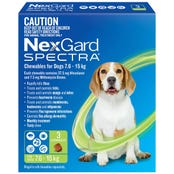Learn about fleas, ticks and worms
Your puppy needs to be protected against fleas, potentially deadly ticks, and mites year-round using parasite control products. With products such as NEXGARD SPECTRA® you can keep them safe from with one easy monthly chew. Find out more about the effects these nasty parasites can have on your best friend.
Fleas
- The flea life cycle consists of four stages; eggs, larvae, pupae, and adults. Of these, only the adults live on your pet, with the rest found in the environment where your pet lives and sleeps.
- Fleas can make your pet irritable, cause allergic skin conditions and can transmit diseases and tapeworms
- One female flea can lay up to 50 eggs per day. These fall off into the environment to develop into larvae, then pupae and finally emerge as new adult fleas 3 weeks to 6 months later, depending upon temperature and humidity.
- It is these newly emerged adult fleas that may re-infest your pet. These environmental stages actually account for 95% of the problem – the adult fleas you may see on your pet are only the tip of the iceberg
- The most affected areas to be targeted by fleas are the rump, thighs, tail base, belly, flanks and upper arms/arm pits
- Pets can pick up fleas anywhere – in your yard, home, or at the park - at any time of the year, so it is important to regularly treat your pet and its environment Signs that your pet may have fleas
- Adult fleas feed on blood, breed and lay eggs on the pet’s coat
- Flea droppings or flea eggs in a dog’s coat or environment
- Skin abrasions and excessive scratching, rubbing licking, biting/ chewing at skin
- Patches of hair loss
- Scabs
- Pale gums
- Tapeworms (segments or larvae on or around the dog’s anus and in the stool)
Ticks
BROWN DOG TICKS
- Brown dog ticks may cause skin irritation and heavy infestations may result in anaemia from excessive blood loss.
- They can also carrypathogens like Babesia canis and Ehrlichia canis which may be transmitted to your dog and cause severe, and potentially fatal disease.
- They are widely distributed throughout Australia, but most prevalent in northern and inland regions.
BUSH TICKS
- Found along parts of the east and west coast of Australia.
- Cause skin irritation in dogs.
- Can transmit Babesia canis, a parasite which causes anaemia in dogs, which can be fatal.
PARALYSIS TICKS
- One of the most dangerous parasites that can affect your pet. Toxins produced by these ticks can cause paralysis and even death.
- Two species of paralysis ticks can infest dogs in Australia: - The eastern paralysis tick is the primary cause of tick paralysis and is found along the east coast from North Queensland to Victoria. The southern paralysis tick is found in Tasmania, southern Victoria and south east New South Wales.
- If your dog lives in or visits a high risk paralysis tick area, it is important to look out for signs of toxicity.
SIGNS OF TOXICITY - If any of these signs appear in your pet you should visit your nearest vet immediately.
- Loss of coordination in the hind legs (wobbly or not being able to get up).
- Change in voice or bark.
- Retching, coughing or vomiting.
- Loss of appetite. - Do not offer food or water. Paralysis ticks can cause difficulty swallowing, which may lead to food or water ending up in the lungs, resulting in pneumonia and breathing difficulties.
- Progressive paralysis starting in the hindlegs and progressing to include the forelegs.
- Difficulty breathing or rapid breathing
Worms
- If left untreated, worms can be fatal to pets. Some worms can also be a health risk to humans
- Detecting infection can be difficult as worm eggs are too small to be easily visible in pet faeces and some worm infestations can show few or no symptoms
- The main types of intestinal worms are heartworms, tapeworms, roundworms, whipworms and hookworms
- Year-round treatment is important to help care for your pet and protect your family Signs that your pet may have worms
- Itchy bottom and ‘scooting’ (dragging bottom along the ground)
- Vomiting
- Diarrhoea
- Weakness, listlessness
- Weight loss (regardless of a good appetite) or change in appetite
- Dull coat or dry hair
- Abnormally swollen stomach (particularly when young)
- Breathing difficulties
- Eating more
Treatment
- Pets are checked for fleas and worms during their annual check-up at Our Vet
- Flea and worming treatments vary according to the type and size of pet and preferred treatment type (e.g. chewable tablet, spray)
- With NexGard Spectra you can keep your puppy protected against Fleas, Ticks, Heartworm, Intestinal Worms (hookworm, whipworm, roundworm & flea tapeworm) and Mites (sarcoptes mites, ear mites and dermodex mites).
Tips to remain flea and worm free
- Be sure to treat all your pets for both fleas and worms
- Clean your pet’s sleeping area regularly
- Remove pet faeces from your pet’s environment regularly
- Try to ensure your pet doesn’t eat rodents or rabbits, which may carry diseases, fleas and worms
A Best Friends team member or Our Vet clinician can recommend the appropriate flea and worming treatment for your pet.


Important Puppy Milestones
Most dogs are considered puppies for their first year, and whilst growth rates may differ for each breed, there are some general important milestones you can expect
Birth to 2 months
You’re most likely to adopt a puppy from eight weeks of age, so chances are they are already past this milestone. A lot of development happens in this first eight weeks, so if you need more information, contact our friendly team at your local Our Vet clinic.
2 months
Vaccinations are important. The vaccination course usually startsu at 6-8 weeks of age. It’s also important to discuss ongoing parasite control with your veterinarian at Our Vet.
2 to 5 months
Your dog’s personality will start to emerge. Connections and bonds strengthen with the family. This is a critical time to learn trust, and establish a core territory – where they feel safest. At Best Friends Pets you can learn all the basics with our 5-week Puppy School program. Puppy school programs are well worth doing, and great for helping to socialise your dog.
More vaccinations are due and toilet training starts. Remember though, some puppies won’t have full control of their bladder until 5-6 months old.
As their adult teeth develop they will begin to chew, so be ready with chew toys otherwise your favourite sneakers might get destroyed. Discuss with your veterinarian the best time to have your puppy microchipped if it has not already been done.
6 to 9 months
This is the typical age for puppies to be desexed. Your veterinarian will be the best person to advise you on the optimal time to arrange this. You’ve probably completed puppy school, so now is the time to consider reward-based training with a reputable dog trainer. This is also when the chewing may ramp up so make sure you have plenty of appropriate chew toys ready to help save your shoes and furniture.
9 to 12 months
Remember you still have a puppy who is learning, so continue their training regularly. Some bigger dogs aren’t fully mature until 18 months. Keep up the training, keep up the fun, and keep up the cuddles.
Keep them protected with NexGard Spectra chews


















